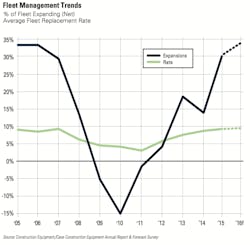As demand for construction projects builds, so does the demand for the equipment to do that work. Construction equipment-fleet managers who put in place acquisition and maintenance strategies to weather the downturn of the past several years now see opportunity to ramp up and replenish fleets.
Acquisition decisions, however, include new equipment with engine-emission technology. Fleet managers will consider the cost of Tier 4-Final machines as they adjust strategies for not only purchase and rental, but also maintenance and lifecycle management.
They will adjust, according to results from this year’s survey of Construction Equipment subscribers. Among those who responded to our 2015-16 Annual Report and Forecast questionnaire, the outlook is positive. They expect to expand their fleets of construction equipment this year and replace machines that have expended their useful lives.
Construction Sector Reports
Last year’s business-year rating exceeded expectations. At the end of 2014, fleet managers predicted a “good” business year for 2015; instead, 2015 turned out to be “very good.” Notably, this is the highest rating for business in several years. The momentum is expected to carry into 2016, with managers forecasting it to also be “very good.” Since equipment fleets represent the most capital-intensive investment a construction organization has, fleet manager sentiment reflects the industry’s willingness and ability to put machines to work.
Contract volume trends support this notion. Expectations for 2015 were solid, and the year outperformed the forecast. In fact, 2015 marked the third consecutive year that the percentage of respondents reporting volume increases outweighed the percentage reporting decreases. This net percentage (increases minus decreases) was 39.6 percent for 2015, up from 31.9 in 2014 and completely reversing the net of -15.4 percent recorded in 2011.
Expectations for 2016 are even more positive, with a net of 44.2 percent (56.3 percent expecting contract volume to increase minus 12.1 percent expecting it to decrease). The 5-point increase in net compared to 2015 comes from a reduction in the percentage of managers expecting volume to decline: 18 percent in 2015 versus 12.1 percent in 2016.
A similar trend exists with expectations for bid prices. Last year, the net was 45.9 percent, with 55 percent of managers expecting increases minus 9.1 expecting decreases in bid prices. This year, the net is 58.9 percent. Some 62.9 percent expect their operations to increase bid prices, and only 4 percent expect those prices to go down.
Fleet trends
In response, fleets expanded in 2015 at a pace not seen since 2007. Last year, fleet managers tempered their expectations on fleet changes for several reasons, including transportation funding uncertainties and new engine technologies on equipment. As the year progressed, however, fleet expansion opened up.
At the end of 2014, 27 percent of fleet managers expected to increase fleet size in 2015 and 10 percent expected to decrease fleet. That left a forecast net of 17 percent. Actual percentages for 2015 provide a net of 29.9 percent (38.5 percent reporting fleet expansion in 2015 minus 8.6 percent with fleet decreasing in size).
For 2016, expectations continue strong. Some 37.8 percent expect to grow fleet this year minus 4.7 who
expect to decrease fleet for a net of 33.1 percent.
Machine-replacement rates are also reaching pre-recession numbers. This year, respondents forecast an average replacement rate of 9.4 percent, well within the historically healthy range of 9 percent to 10 percent. The rate in 2015 was also healthy at 9.1 percent and also beat expectations; the forecast rate was 8.8 percent.
Fleet health, directly related to replacement rates, continues to strengthen. In 2011, less than 40 percent of respondents said their fleets were in “very good” or “excellent” condition, and 15 percent reported fleet health as either “fair” or “poor.” In 2015, 45.6 percent of respondents said their fleets were in “excellent” or “very good” condition. About 13 percent rated health at “fair” or “poor.”
About half, 51.1 percent, of fleet managers say they purchased machines outright in 2015, and 37 percent said they purchased by financing the machine. Rental/purchase agreements were employed by 19.8 percent of managers, a strategy that continues to grow. Leasing also grew in 2015, with 22.5 percent of managers using either a lease or a lease/purchase to acquire equipment.
Short-term rental remains a strong strategy, with 32.2 percent of managers saying they increased their use in 2015, up from 29.1 percent in 2014. The American Rental Association anticipates equipment rental industry revenue growth in the United States of 6.7 percent in 2016.
As fleets expand, equipment department hiring follows. In 2015, 39.1 percent of fleet managers said they increased their department workforce. Service and maintenance hiring increased for 22.5 percent of managers, and “other hourly labor” increased for 38.3 percent. The number of equipment operators employed increased for 30.4 percent of respondents.




